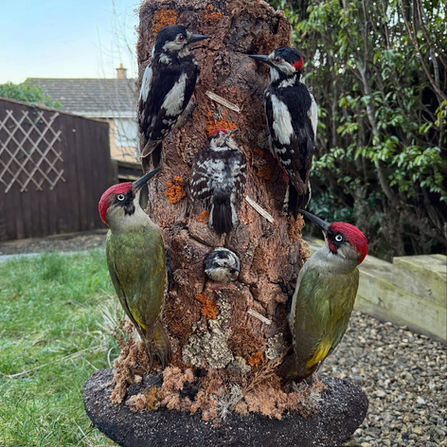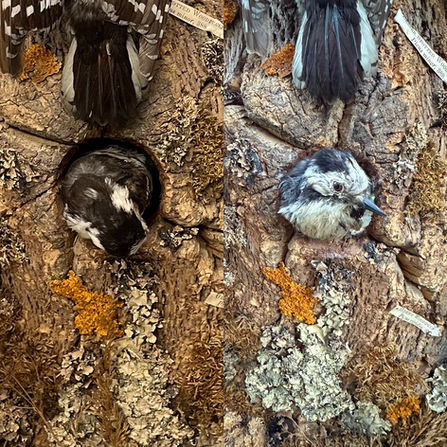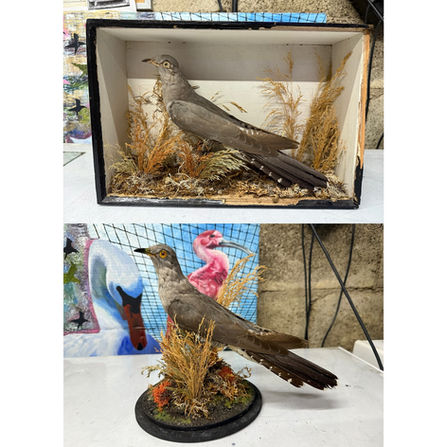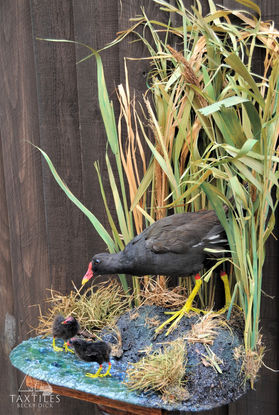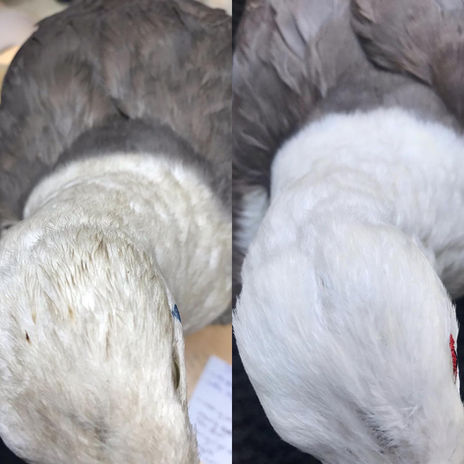Bird Restoration
All work here is client commissioned work to either restore the habitat surrounding a piece of taxidermy, recasing a specimen or restoring/cleaning a specimen. From private collections to museum collections.
Every piece is bespoke and catered to the clients needs. No habitat restoration, taxidermy restoration/cleaning or recasing is the same.
If there is something you can't find here and want to find out more. Please do not hesitate to email taxtiles.taxidermy@gmail.com
Woodpecker Restoration
An unusual example of a collection of UK native woodpeckers. They needed to be remounted onto a more suitable base and a good cleaning with some paintwork restoration done to the beak and feet. You can also spot the now rare lesser spotted woodpeckers (middle). There's an example of a male and female in the photos.
This will now be displayed at the John Moore Museum in Tewkesbury.
Kingfisher Restoration
Here are a pair of kingfishers I restored and remounted in a new dome. They were very badly damaged from a past pests, either moths or carpet beetles. The branch they were originally on looked like it has broken inside the case. Once the kingfishers were out of the old case, the damage on the birds was a lot worse than anticipated. Luckily I had some spare kingfisher parts and had to sadly dispose of whatever came off the antique kingfishers as they were so badly damaged from the pests, after a strong fumigation, wing and tail transplants on both specimens. Plus the beaks and feet were restored and painted. They are now looking much happier.
Cuckoo Restoration
An unusual example of a Victorian Cuckoo was in dire need of some cleaning, a new set of eyes and a remount. The specimen wasn't in the greatest of conditions as there was fat burn on the skin (due to poor processing) so the restoration was limited. However, after a clean, new set of eyes fitted and re-mounted on a new base to go with the rest of the John Moore Museum collection. It shows a bird that unfortunately is a rare sight to see in the 21st century.
Barn Owl Restoration
This Barn owl needed a little tlc, a full fumigation and clean was undertaken.
As well as restoring the colour back into the beak and the feet.
Restoring a capercaillie, new groundwork and case.
This capercaillie was in dire need of some tlc, with one of its wings broken off, very dusty and faded. It needed a complete overhaul. I set to work and fixed the wing, and gave the whole bird a deep clean which did wonders for the plumage. Recoloured the beak and feet. Cleaned the eyes too and did some touch-ups on the red part above the eye. The bird was then taken off its old base and put on a new one with some fresh groundwork. A brand new case was made to measure the capercaillie, oak beaded with an oak base. As you can see the capercaillie is looking much happier in its new surroundings.
Before and after of a storm petrel study skin into a mounted specimen.
This study skin of a storm petrel was from the James Harrison collection with sadly no data to go with it. So it was then donated to me to see if I could mount it as a taxidermy specimen. After speaking to some other taxidermists about methods of rehydration. I then gave it a go and it was successful. Not all study skins are viable for rehydration as a mounted taxidermy specimens. So if you wanted this type of work done, you would have to be completely happy with the risk of it falling apart.
Restoring and remounting antique moorhens and kingfishers for The John Moore Museum
I was tasked with inspecting this very old case that originally came from Bristol Museum and was gifted to The John Moore Museum around 30 years ago. It's large and took up a lot of space in the Museum and the heritage manager had also noticed that pests had gotten into the case itself. Thankfully action was taken in time to save the specimens.
It was decided it was time for the case to be dismantled and the specimens; a pair of Kingfishers and a family of Moorhens, repurposed into 3 separate displays to save space and to allow them to be rotated with the rest of the museum's taxidermy collection. This would also allow the specimens to be easily cared for and maintained as the size of the previous case made them hard to access.
The groundwork was repurposed and anything that wasn't used was recycled. The specimens were quarantined, fumigated, to ensure no pests remained, and then cleaned and recoloured to restore them to their former glory.
Before and after of a restoration of 2 antique museum birds
These birds are part of the Reading museum collection. I was given the task to restore both of these birds which had a very bad infestation of carpet beetles. The glass had to be taken off first before working on them. As the feathers were loose due to the infestation, I had to be very careful not to remove the feathers while cleaning them as they would fall out. There was also cracking in the back of the case as well which needed to be sealed to stop any unwanted pests coming into the case in the future. Both specimens had been fumigated. So this was a historical infestation.
Both birds were restored using museum grade conservation techniques which can be easily reversed if needed be. The beak sheaths and parts of the claws were also restored and recoloured. Once the restoration work had been completed, I re-taped and coloured the tape holding the glass and the case.
Before and after of a restoration of exotic antique birds
Gave these birds a very overdue clean and freshen up. Recoloured parts where there were missing feathers, fumigated, new eyes in most of the birds (I know not scientifically correct but the clients request). Took the whole diorama from it's original base as the glass dome had smashed. Supplied a new modern dome for the birds. As the new dome was a bit on the short side. The backing board holding the birds and diorama needed to be cut down to size to accommodate this. Diorama on the base was also overhauled and redone as you can see in the before and after.
Before and after of fumigating and restoring a Crow
The poor crow was in dire need of cleaning and fumigation. It had moth eggs around it's feet, but luckily it was caught in time for treatment. I fumigated and quarantined the specimen for a few weeks before working on it to make sure the infestation stopped spreading. Luckily it only got to the feet. However I had another contender to be challenged with. Fat burn (when a bird hasn't been cleaned properly during processing of mounting and the fat seeps out of the skin into the feathers). This makes the specimen very fragile. So I had to work very carefully when cleaning. I also steamed the wing feathers to join the missing parts together. And finally once degreased and washed, I went around with black pan pastels around the missing feathers to blend in with black feathers. Cleaned around the eyes and fixed the skin under the beak. I'm confident to say it looks alot better than before!

Before and after of a restoration of a Pheasant
This great example of an antique pheasant needed some well overdue TLC. Unfortunately the moths got to the tail and some of the feathers on the specimen. Luckily when the infestation was found, The general specimen could be saved. I was tasked with cleaning the specimen and transplanting a new tail. Paintwork around the wattle and recasing the bird with new foliage. You can see the before and after photos on the left. A large but very satisfying project!
Before and after of a restoration of a lesser black-backed seagull
This seagull needed some well overdue TLC. You can see in the before amd after shots how well this guy came out after a good clean. I also added eye rings and fixed his boots so they're in the right position.
Before and after of a restoration of an antique
barn owl.
This antique barn owl had a little accident and the glass smashed. So I was tasked with recasing it as well as modernising the surrounding perch. I found out this was preserved way back in 1902, while I was taking the paper mache rock apart to get to the owl. It was pretty nailed to it! Now it happily sits in its new dome (still antique).
Note: this is not my taxidermy but me recasing and remounted the specimen in another antique glass dome.
It’s also pre 1947 so no need for an A10.
Before and after of a restoration of a sparrow hawk.
Habitat was tired and faded so that was restored with new and brighter habitat. There was minor feather loss from moths and splitting above the ankle of the birds feet so that was fixed too and cleaned the feathers.
Re-painted around the eyes and above the beak. Also fumigated the specimen so it is protected from future pests.
Note: this is not my taxidermy but me restoring the specimen, fixing issues with the legs and restoring the habitst. it’s also pre 1947 so no need for an A10.

Before
After
 |
|---|
Before
After
Before and after of an antique tawny owl.
Very dusty cleaned specimen of heavy dust and dirt. Repositioned as the tawny owl was looking down due to a split in the neck/head of the skin which was fixed. Some of the tail feathers were bent so I steamed those back into place.
Also refeathered the specimen and repositioned the wood on the base to give a nicer composition. Also cleaned his feathers, eyes and inside of his beak. Currently being fumigated so it is protected from pests.
Note: this is not my taxidermy but me cleaning and doing a bit of conservation on the specimen, it’s also pre 1947 so no need for an A10.
 |
|---|
Before
After
Before and after of an antique barn
Note: this is not my taxidermy but me cleaning and doing a bit of conservation on the specimen, it’s also pre 1947 so no need for an A10.








